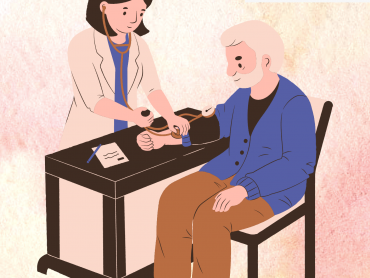Nurses form the backbone of medical care worldwide. It is the nurse who sees to it that the patient is cared for according to the orders given. The change of bedding, dressing, saline, sponging, timely injections, measuring intake and output, shifting of patients, assisting during procedures and surgery, etc. are all part of the myriad tasks performed by nurses. It is thus obvious that nurses need a uniform that stands up to the challenge of appearing serene and clean, amidst the pain and suffering in a hospital along with offering the wearer ease of movement, besides instant identification as nursing staff.
Although medical care has a history going back hundreds of years, nursing as a profession did not evolve until the late 19th century. Nursing a patient at home was often done by the women in a family, or servants or even women of ‘lower classes’. If at all nursing was needed in a hospice, it was the nuns who performed the tasks. This is the origin of the appellation “Sister” that is attached to a female nurse.
FIRST NURSES AND THE FIRST UNIFORM

Nurse Uniform during the Crimean war
When wars were fought and the wounded and dying needed succour in battlefields and army hospitals, their family could often not reach them. Here again, nuns performed the task of nursing and it was acknowledged as a task of sacrifice and compassion. Nursing care of men, who were not family, involved intimate tasks and was considered taboo for the general population.

Florence Nightingale in uniform(Image Source: Google)
Florence Nightingale was the first nurse to break this taboo during the Crimean War in the 1850s with her selfless work among the wounded soldiers. Her dress closely resembles a nun’s dress. A cap for concealing hair, a white pinafore to cover her long dress and long sleeves are the iconic nurses’ first uniform.
FIRST NURSES’ ACADEMY
Ms Nightingale set up the first Training School for Nurses in 1860, and the acknowledgement of nursing as a profession resulted in the first conceptualization of a Nurses’ uniform. Indeed, the first uniform was designed by Ms Nightingale’s student, Miss. Van Rensselaer.
Uniforms were white or blue, ankle length with long sleeves and high closed necks and collars with a pinafore that was also ankle length. The uniform had no pockets. There was a mandatory cap and the hair had to be compactly tied up and concealed beneath it. Travelling nurses wore capes.
CHANGES WITH TIME AND NEED
In the Early 1900s, as hierarchy among nurses was established which required them to have different colours of uniform to differentiate between the classes of nurses, for eg. Midwife, Staff nurse, Ward-in-charge, Matron, etc. Nurses with higher positions wore darker uniforms.

Army nurse in world war 2(Image Source: History Grand Rapids)
The advent of the World Wars gave the profession of Nursing a boost due to the sheer number of the wounded, the outreach that was required, challenges of the terrain and weather, etc. An estimated 50,000 nurses were operational in different parts of the world during World War II.
Nurses wore uniforms in brown, khaki, green, etc. due to acute to the shortage of fabric and the need to be practical overrode the rigidity of the uniform code. Nurses wore trousers with shirts or calf length uniforms, wellingtons, trench coats, and steel helmets, while many had the Red Cross symbol on their back, chest, and sleeve to distinguish them. This illustrates how admirably the nursing profession adapted to the need of the hour.
END OF THE WAR-PEACETIME NURSING!
With the setting up of the NHS in 1948, a new era of medical care was ushered in, and as opinions of the wearers became a relevant consideration, new styles emerged. Across the

Nurse Uniform in the 1950s(Image Source: Google)
Atlantic, as well, the sleeves became shorter and hemlines higher. The closed collar was done away with in the 1960s and a comfortable buttoned neckline appeared. Also, the traditional apron was replaced with a plastic one. Fashion, as well as practicality in uniforms, was a keynote. Easy to wash fabric, uniforms with pockets as also paper caps were introduced.
As ladies hair grew shorter in length, the cap became smaller with each hospital having a unique style of cap. The addition of a coloured belt and stripes to indicate seniority was introduced by some.
The advent of male nurses in the mid 20th century saw the creation of a uniform consisting of a white trouser and an apron-like a jacket.
CHANGES IN UNIFORM

Modern Scrubs(Image Source: firstuniform.com)
The medical profession decided to reduce the use of white towards the end of the twentieth century, as a profusion of white was jarring to the eye as well as impractical for maintenance.
It became prudent for nurses’ uniforms to graduate to pastels as well. Caps, which by then were ornamental or merely traditional, became optional. With time, nurses wore scrubs and comfortable shoes that were identical to what doctors wore, with colour coding for identification.
INDIAN UNIFORMS

Indian Nurse Uniform(Image Source: Exporters India)
Many Private-run hospitals in India now have pastel scrubs or uniforms with a tunic or trouser pattern.
Nurses’ uniforms in India aped the British style for a long time. Knee/calf dress with belt and a cap in white was the norm and is still followed in many Indian hospitals, particularly the state and municipal-run ones.
Although the demand to allow sarees and salwar-kameez are pending, it is perhaps a logical one, considering the traditional sensibilities of the population and the demands of the job.








